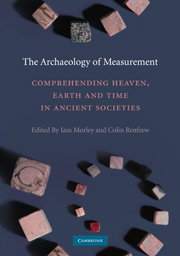Book contents
- Frontmatter
- Contents
- List of figures and tables
- List of contributors
- Acknowledgements
- The Archaeology of Measurement
- Introduction: Measure: Towards the construction of our world
- SECTION I NUMBER: COUNTING, MATHEMATICS AND MEASURE
- SECTION II MATERIALISING THE ECONOMY
- SECTION III DIMENSIONS AND BELIEF
- SECTION IV CALENDAR AND COSMOLOGY
- 14 The measurement of time and distance in the heavens above Mesopotamia, with brief reference made to other ancient astral sciences
- 15 Evolution of the calendar in Shang China
- 16 The measure of time in Mesoamerica: From Teotihuacan to the Maya
- 17 Measuring time, sacred space, and social place in the Inca Empire
- 18 Measuring time in the European Neolithic? The function and meaning of Central European circular enclosures
- SECTION V THE SPIRITUALITY OF MEASURE
- Index
- References
16 - The measure of time in Mesoamerica: From Teotihuacan to the Maya
Published online by Cambridge University Press: 05 June 2012
- Frontmatter
- Contents
- List of figures and tables
- List of contributors
- Acknowledgements
- The Archaeology of Measurement
- Introduction: Measure: Towards the construction of our world
- SECTION I NUMBER: COUNTING, MATHEMATICS AND MEASURE
- SECTION II MATERIALISING THE ECONOMY
- SECTION III DIMENSIONS AND BELIEF
- SECTION IV CALENDAR AND COSMOLOGY
- 14 The measurement of time and distance in the heavens above Mesopotamia, with brief reference made to other ancient astral sciences
- 15 Evolution of the calendar in Shang China
- 16 The measure of time in Mesoamerica: From Teotihuacan to the Maya
- 17 Measuring time, sacred space, and social place in the Inca Empire
- 18 Measuring time in the European Neolithic? The function and meaning of Central European circular enclosures
- SECTION V THE SPIRITUALITY OF MEASURE
- Index
- References
Summary
Thus it was recorded [by] the first sage, Melchise [dek], the first prophet, Napuc Tun, the priest, the first priest. This is a song of how the uinal [20-day period] came to be created before the creation of the world. Then he began to march by his own effort alone. Then said his maternal grandmother, then said his maternal aunt, then said his paternal grandmother, then said his sister-in-law: “What shall we say when we see man on the road?” These were their words as they marched along, when there was no man [as yet]. Then they arrived there in the east and began to speak. “Who has passed here? Here are footprints. Measure it off with your foot.” So spoke the mistress of the world. Then he measured the footstep of our Lord, God, the Father. This was the reason it was called counting off the whole earth, lahca (12)Oc. This was the count, after it had been created by [the day] 13 Oc, after his feet were joined evenly, after they had departed there in the east. Then he spoke its name when the day had no name, after he had marched along with his maternal grandmother, his maternal aunt, his paternal grandmother and his sister-in-law. The uinal was created, the day, as it was called, was created, heaven and earth were created, the stairway of water, the earth, rocks and trees; the things of the sea and the things of the land were created.
(Roys 1967, 116–117, author's brackets)- Type
- Chapter
- Information
- The Archaeology of MeasurementComprehending Heaven, Earth and Time in Ancient Societies, pp. 203 - 215Publisher: Cambridge University PressPrint publication year: 2010
References
- 5
- Cited by



